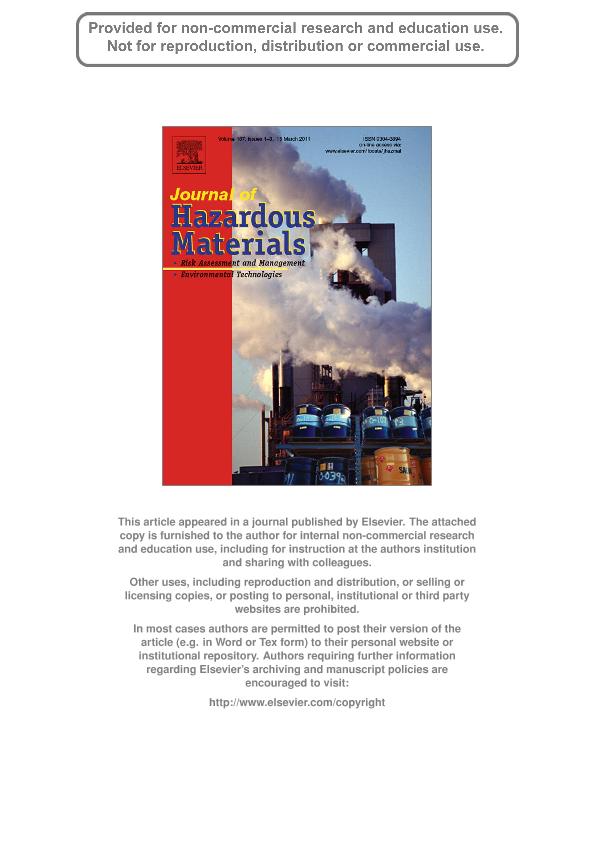Mostrar el registro sencillo del ítem
dc.contributor.author
Rodriguez, Judith Hebelen

dc.contributor.author
Klumpp, A.
dc.contributor.author
Fangmeier, A
dc.contributor.author
Pignata, Maria Luisa

dc.date.available
2019-10-24T17:57:02Z
dc.date.issued
2011-03
dc.identifier.citation
Rodriguez, Judith Hebelen; Klumpp, A.; Fangmeier, A; Pignata, Maria Luisa; Effects of elevated CO2 concentrations and fly ash amended soils on trace element accumulation and translocation among roots, stems and seeds of Glycine max (L.) Merr.; Elsevier Science; Journal of Hazardous Materials; 187; 1-3; 3-2011; 58-66
dc.identifier.issn
0304-3894
dc.identifier.uri
http://hdl.handle.net/11336/87215
dc.description.abstract
The carbon dioxide (CO2) levels of the global atmosphere and the emissions of heavy metals have risen in recent decades, and these increases are expected to produce an impact on crops and thereby affect yield and food safety. In this study, the effects of elevated CO2 and fly ash amended soils on trace element accumulation and translocation in the root, stem and seed compartments in soybean [Glycine max (L.) Merr.] were evaluated. Soybean plants grown in fly ash (FA) amended soil (0, 1, 10, 15, and 25% FA) at two CO2 regimes (400 and 600 ppm) in controlled environmental chambers were analyzed at the maturity stage for their trace element contents. The concentrations of Br, Co, Cu, Fe, Mn, Ni, Pb and Zn in roots, stems and seeds in soybeans were investigated and their potential risk to the health of consumers was estimated. The results showed that high levels of CO2 and lower concentrations of FA in soils were associated with an increase in biomass. For all the elements analyzed except Pb, their accumulation in soybean plants was higher at elevated CO2 than at ambient concentrations. In most treatments, the highest concentrations of Br, Co, Cu, Fe, Mn, and Pb were found in the roots, with a strong combined effect of elevated CO2 and 1% of FA amended soils on Pb accumulation (above maximum permitted levels) and translocation to seeds being observed. In relation to non-carcinogenic risks, target hazard quotients (TQHs) were significant in a Chinese individual for Mn, Fe and Pb. Also, the increased health risk due to the added effects of the trace elements studied was significant for Chinese consumers. According to these results, soybean plants grown for human consumption under future conditions of elevated CO2 and FA amended soils may represent a toxicological hazard. Therefore, more research should be carried out with respect to food consumption (plants and animals) under these conditions and their consequences for human health.
dc.format
application/pdf
dc.language.iso
eng
dc.publisher
Elsevier Science

dc.rights
info:eu-repo/semantics/openAccess
dc.rights.uri
https://creativecommons.org/licenses/by-nc-sa/2.5/ar/
dc.subject
Glycine max
dc.subject
Trace elements
dc.subject
Fly ash amended soils
dc.subject
Food safety
dc.subject.classification
Ciencias Medioambientales

dc.subject.classification
Ciencias de la Tierra y relacionadas con el Medio Ambiente

dc.subject.classification
CIENCIAS NATURALES Y EXACTAS

dc.title
Effects of elevated CO2 concentrations and fly ash amended soils on trace element accumulation and translocation among roots, stems and seeds of Glycine max (L.) Merr.
dc.type
info:eu-repo/semantics/article
dc.type
info:ar-repo/semantics/artículo
dc.type
info:eu-repo/semantics/publishedVersion
dc.date.updated
2019-09-24T15:30:33Z
dc.journal.volume
187
dc.journal.number
1-3
dc.journal.pagination
58-66
dc.journal.pais
Estados Unidos

dc.description.fil
Fil: Rodriguez, Judith Hebelen. Consejo Nacional de Investigaciones Científicas y Técnicas. Centro Científico Tecnológico Conicet - Córdoba. Instituto Multidisciplinario de Biología Vegetal. Universidad Nacional de Córdoba. Facultad de Ciencias Exactas Físicas y Naturales. Instituto Multidisciplinario de Biología Vegetal; Argentina
dc.description.fil
Fil: Klumpp, A.. Universität Hohenheim. Institute of Landscape and Plant Ecology; Alemania
dc.description.fil
Fil: Fangmeier, A. Universität Hohenheim. Institute of Landscape and Plant Ecology; Alemania
dc.description.fil
Fil: Pignata, Maria Luisa. Consejo Nacional de Investigaciones Científicas y Técnicas. Centro Científico Tecnológico Conicet - Córdoba. Instituto Multidisciplinario de Biología Vegetal. Universidad Nacional de Córdoba. Facultad de Ciencias Exactas Físicas y Naturales. Instituto Multidisciplinario de Biología Vegetal; Argentina
dc.journal.title
Journal of Hazardous Materials

dc.relation.alternativeid
info:eu-repo/semantics/altIdentifier/url/https://www.ncbi.nlm.nih.gov/pubmed/21146924
dc.relation.alternativeid
info:eu-repo/semantics/altIdentifier/doi/http://dx.doi.org/10.1016/j.jhazmat.2010.11.068
Archivos asociados
